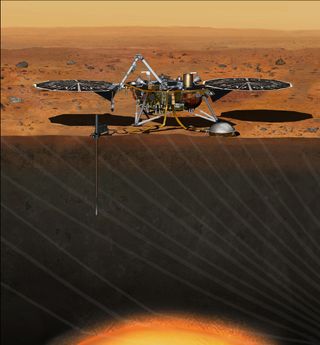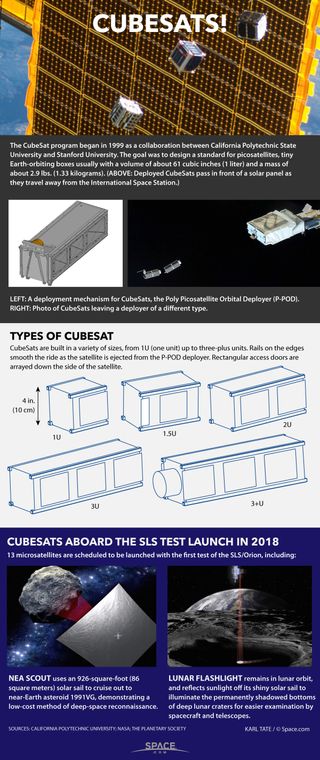Two Tiny 'CubeSats' Will Watch 2016 Mars Landing

NASA will launch a pair of bantam CubeSats into deep space next year to provide real-time landing coverage for the space agency's next mission to Mars, officials say.
Known as Mars Cube One or MarCO, the CubeSats will be launched in March 2016 as secondary payloads aboard an Atlas V rocket carrying NASA's InSight lander. The two CubeSats will separate from the booster after launch and travel along their own trajectories to the Red Planet.
One of the MarCO spacecraft will serve as a relay satellite to send data back to Earth during InSight's entry, descent and landing operations at the Red Planet in September 2016. The other spacecraft will serve as a backup. [Images: NASA's InSight Mars Lander Mission]
The MarCO mission will be a major step forward in the development of CubeSats, which to date have been used primarily in Earth orbit, said Andrew Klesh of NASA's Jet Propulsion Laboratory (JPL) in Pasadena, California.
"We've done a lot over the last 10 years, the last 10 to 15 years, to build up CubeSats," Klesh said. "Now, in 2016, CubeSats are going to Mars," Klesh said at the 12th Annual CubeSat Developers' Workshop in San Luis Obispo, California, where he unveiled the MarCO mission.

Klesh said NASA would not have real-time telemetry from InSight's descent and landing without the MarCO spacecraft. InSight will transmit data to NASA's Mars Reconnaissance Orbiter (MRO), which is now circling the planet. However, MRO will move behind the planet before it can transmit the data back to Earth, resulting in a delay of several hours, Klesh said.
"To perform all of this, we've developed two 6U CubeSats. It takes advantage of a number of the technologies we have been developing at JPL as well as in partnership with many of the vendors within this community," Klesh said.
Get the Space.com Newsletter
Breaking space news, the latest updates on rocket launches, skywatching events and more!
A CubeSat is a small satellite whose standard size is 4 by 4 by 4 inches (10 by 10 by 10 centimeters), a size known as 1U. CubeSats can be expanded in 1U increments along a single axis; for example, the two 6U MarCO CubeSats each measure about 12 by 8 by 4 inches (30 by 20 by 10 cm).
The two spacecraft feature a propulsion system that includes four attitude-control and trajectory-control thrusters. Each spacecraft will make five course corrections on the way to Mars to make sure they are properly positioned to relay data back to Earth during InSight's entry and landing sequence, Klesh said.
"One of the most notable features on the front side of this panel is the reflector array at the bottom there," he added. "This X-band reflector array allows us to close a link of 8 kilobits per second at over 157 million kilometers [98 million miles] from Mars back down to Earth during the InSight entry, descent and landing sequence."
The MarCO spacecraft will not enter orbit around the Red Planet but will continue on into deep space.
InSight, which stands for Interior Exploration using Seismic Investigations, Geodesy and Heat Transport, will be the first spacecraft to examine the interior of Mars. The goal is to better understand the processes involved in terrestrial planet formation and to measure the Red Planet's vital signs.
While past landers have scooped up soil for analysis, InSight has a heat-flow probe and seismic experiment to measure the temperature and conditions beneath the surface. It also has an experiment that uses the spacecraft's communications system to precisely measure the planet's rotation.
InSight is being managed by JPL, which is providing the planetary-rotation experiment. The heat-flow package is provided by the German space agency DLR, while the French space agency CNES provided the seismic experiment.
Editor's note: This story was updated on June 15 to correct the distance from Mars to Earth at the time of transmission, as well as the size of the MarCO cubesats and data transmission rate.
Follow us @Spacedotcom, Facebook or Google+. Originally published on Space.com.
Join our Space Forums to keep talking space on the latest missions, night sky and more! And if you have a news tip, correction or comment, let us know at: community@space.com.
Douglas Messier is the managing editor of Parabolicarc.com, a daily online blog founded in 2007 that covers space tourism, space commercialization, human spaceflight and planetary exploration. Douglas earned a journalism degree from Rider University in New Jersey as well as a certificate in interdisciplinary space studies from the International Space University. He also earned a master's degree in science, technology and public policy from George Washington University in Washington, D.C. You can follow Douglas's latest project on Twitter and Parabolicarc.com.
